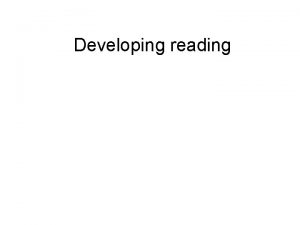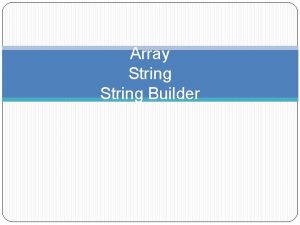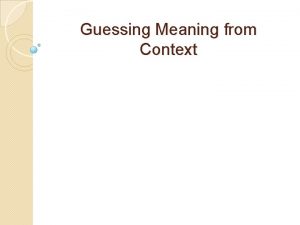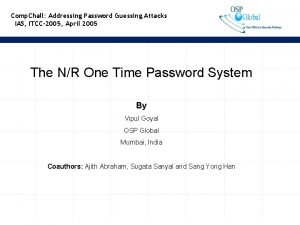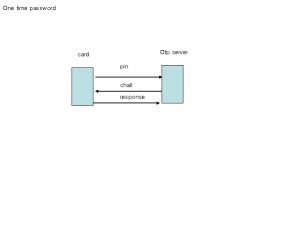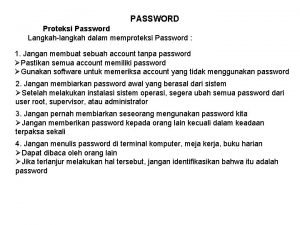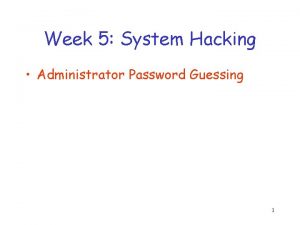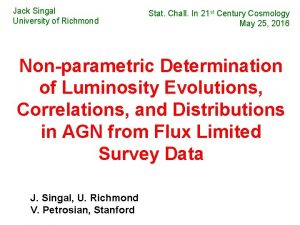Comp Chall Addressing Password Guessing Attacks IAS ITCC2005
















- Slides: 16

Comp. Chall: Addressing Password Guessing Attacks IAS, ITCC-2005, April 2005 Comp. Chall: Addressing Password Guessing Attacks By Vipul Goyal OSP Global Mumbai, India Coauthors: Virendra Kumar, Mayank Singh, Ajith Abraham and Sugata Sanyal 1

Comp. Chall: Addressing Password Guessing Attacks IAS, ITCC-2005, April 2005 Introduction • Passwords are the most widely used means of authentication • Humans have a tendency to choose relatively short and simple passwords • Thus, passwords bring along with them, the threat of dictionary attacks 2

Comp. Chall: Addressing Password Guessing Attacks IAS, ITCC-2005, April 2005 Dictionary attacks • Dictionary attack means guessing the password and somehow check whether it is valid or not • If the rate of guessing and validating is reasonably high, the attacker stands a good chance of breaking the password • Two types: offline and online 3

Comp. Chall: Addressing Password Guessing Attacks IAS, ITCC-2005, April 2005 Offline dictionary attacks • The attacker somehow gets access to some data which allow him to test passwords without any interaction with the server • Theoretically impossible to resist w/o PKC but efficient protocols like EKE exist to resist these attacks using PKC 4

Comp. Chall: Addressing Password Guessing Attacks IAS, ITCC-2005, April 2005 Online dictionary attacks • For each password validation, interaction with the server is required • By attempting a login, it is always possible to test for password validity and hence, these attacks cannot be totally prevented • Common countermeasures like account locking and delayed response are not satisfactory 5

Comp. Chall: Addressing Password Guessing Attacks IAS, ITCC-2005, April 2005 Our protocol • Limits the rate of login attempt by asking the user to first solve a computational challenge • Uses only fast one way hash functions for efficiency • Totally stateless and thus less vulnerable to Do. S attacks 6

Comp. Chall: Addressing Password Guessing Attacks IAS, ITCC-2005, April 2005 Protocol description • Step 1: Alice sends her user ID to Bob • This is a simple step in which Alice indicates her willingness to login 7

Comp. Chall: Addressing Password Guessing Attacks IAS, ITCC-2005, April 2005 Protocol description contd. . • Bob generates two random numbers r and R. r is a small (e. g. 20 bit) random number, R is a big (100 bit) random number • Bob also computes H(r, P) where P is Alice’s password and computes a MAC = H(KBob, H(r, P), Alice, n) • KBob is Bob’s secret key, n is the number of failed attempts by Alice so far • Step 2: Bob replies back with: H(r, R), R, MAC 8

Comp. Chall: Addressing Password Guessing Attacks IAS, ITCC-2005, April 2005 Protocol description contd. . • Alice should find out r before she can proceed with the login attempt. This is done by checking the hash values of all possible 20 bit number appended with R (and matching with H(r, R)) • R acts as a salt to prevent her from pre-computing H(r) for all possible r • This step is computationally intensive for Alice and prevents her from making a large number of login attempts per unit time. 9

Comp. Chall: Addressing Password Guessing Attacks IAS, ITCC-2005, April 2005 Protocol description contd. . • After finding out r, Alice computes H(r, P) • Step 3: Alice sends to Bob: Alice, H(r, P) along with the received MAC (=H(H(r, P), Alice, KBob, n)) • This step can be independently executed making the protocol stateless 10

Comp. Chall: Addressing Password Guessing Attacks IAS, ITCC-2005, April 2005 Protocol description contd. . • Bob hashes the received H(r, P) with its key, Alice, and n and matches the resulting quantity with the received MAC • If they match, Alice is logged in • Else n is incremented. • Bob sends the success/failure signal 11

Comp. Chall: Addressing Password Guessing Attacks IAS, ITCC-2005, April 2005 Protocol figure 12

Comp. Chall: Addressing Password Guessing Attacks IAS, ITCC-2005, April 2005 Protocol Security • The MAC H(H(r, P), Alice, KBob, n) is un-intelligible to Alice and is only meant to be returned to the server. This is to make the server stateless. • This MAC is specific for the user and the login attempt. Thus, this cannot be re-used for any other user / attempting login more than once for a single user • All this ensures that Alice did the required computation 13

Comp. Chall: Addressing Password Guessing Attacks IAS, ITCC-2005, April 2005 Protocol Variant 1 • A minor variation in the message sequence produces interesting results • Replace H(r, R) with H(r, P, R) in step 2 and 3 with MAC=H(H(r, P), Alice, KBob, n) • This rapidly increases the offline dictionary attack time, useful in case SSL protection is not used 14

Comp. Chall: Addressing Password Guessing Attacks IAS, ITCC-2005, April 2005 Protocol Variant 2 • Aimed at making the protocol secure again server compromise • Replace H(P, r) with r, H(i-1)(P) with MAC = H(r, Hi(P), Alice, KBob, n) • Relatively complex, uses Hash chains 15

Comp. Chall: Addressing Password Guessing Attacks IAS, ITCC-2005, April 2005 Thank You 16
 When does reading start
When does reading start Flat addressing vs hierarchical addressing
Flat addressing vs hierarchical addressing Clothes guessing game
Clothes guessing game Word-guessing game using arraylist and stringbuilder c#
Word-guessing game using arraylist and stringbuilder c# Psycholinguistic guessing game
Psycholinguistic guessing game Ayon kay badayos ang pagbasa ay isang proseso ng
Ayon kay badayos ang pagbasa ay isang proseso ng Mropping meaning
Mropping meaning Guessing game
Guessing game Rapid guessing nwea
Rapid guessing nwea Peter tigges
Peter tigges Guessing clipart
Guessing clipart Guessing meaning
Guessing meaning Fun games to play with friends
Fun games to play with friends Kangaroo guessing game
Kangaroo guessing game High low birthday guesser
High low birthday guesser Inside out guessing the feelings
Inside out guessing the feelings Slidetodoc.com
Slidetodoc.com
